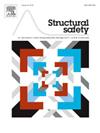Efficient reliability updating methods based on Bayesian inference and sequential learning Kriging
Abstract
Reliability updating is an effective tool for reappraising reliability level of system when new observation information is obtained. The adaptive Kriging based reliability updating method (RUAK) inserts the adaptive Kriging into traditional simulation method to improve the efficiency of reliability updating. However, an identical candidate sampling pool is used to simultaneously estimate the prior failure probability and the posterior one in RUAK, which leads to a waste of computational resources in case of significant difference between the importance regions in estimation of prior and posterior failure probabilities. To overcome this disadvantage, an efficient reliability updating framework based on Bayesian inference and sequential learning Kriging is proposed in this paper. In the proposed method, two candidate sampling pools respectively for estimating the prior and posterior failure probabilities are separately constructed by prior probability density function (PDF) and posterior PDF obtained by Bayesian inference. Then, the Kriging model is established and sequentially refined in these two candidate sampling pools to accurately estimate the corresponding failure probabilities. Through combining different simulation methods with the proposed framework, the Monte Carlo simulation based and importance sampling based sequential learning Kriging methods are respectively developed for reliability updating.

 求助内容:
求助内容: 应助结果提醒方式:
应助结果提醒方式:


